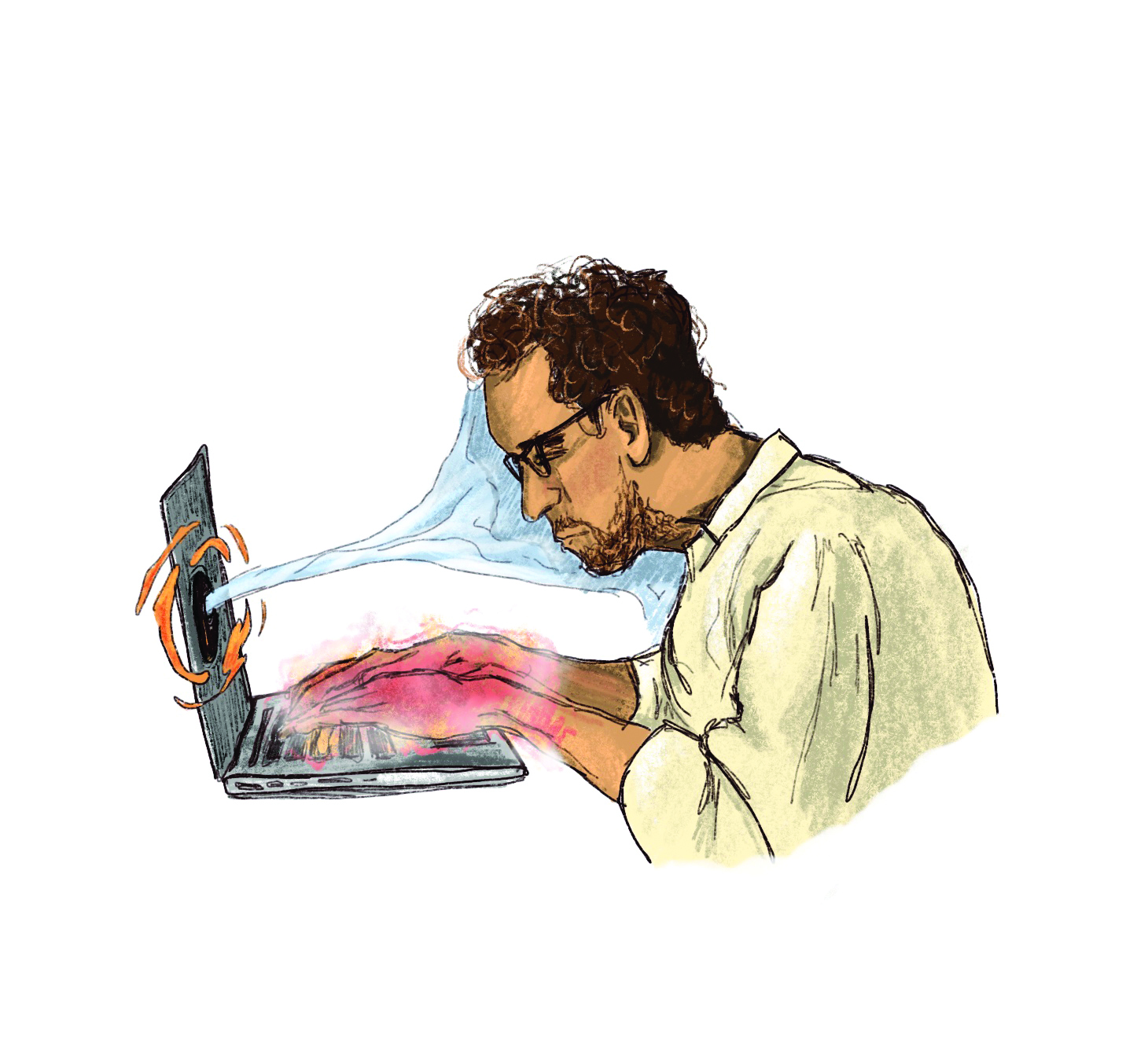Our bodies and tech: a journey through pain and healing
May 14, 2021
 This
piece represents the opinion of the author
.
This
piece represents the opinion of the author
.
 Kayla Snyder
Kayla SnyderBy the end of my first year of college, I suffered from chronic pain in my wrists, neck and back—pain that curtailed my activities as an athlete, musician and student. For some of you, this may sound familiar: a late night cram-session hunched over a laptop coupled with an hour of scrolling on social media and texting friends can do a number on your body.
I was only one of millions with Repetitive Strain Injuries (RSIs) brought on by technology—specifically the ubiquitous, unavoidable use of computers and smartphones. All of us went through many technology-driven lifestyle changes growing up. Starting as early as elementary school, education, socialization and entertainment became increasingly tech-dominated. Although warnings were voiced about the danger of excessive “screen time” for our growing minds, I don’t remember anyone raising the alarm about the impact of heavy keyboard, trackpad and phone use on our bodies. So, like most people with RSIs, I never saw anything tangibly wrong with the increased presence of technology in my life until one day, I realized my hands and wrists ached and burned every time I picked up a glass of water.
It’s surprisingly difficult to find clear data on the impact that technology has had on our bodies—possibly because it negates the interests of the most powerful businesses on the planet. Nevertheless, we do know this: each year in the pre-COVID-19 U.S. alone, RSIs resulted in medical costs of around $120 billion, according to the U.S. Occupational Safety and Health Administration. Carpal Tunnel Syndrome (a common RSI) alone affected some eight million Americans. The COVID-19 era has made our devices even more essential as sources of connection to the world, and this has only increased our exposure to these issues.
The severity of my pain escalated at Bowdoin. The more complex and time-consuming nature of college academics meant that the amount of time I spent typing and clicking was a huge step up from high school. Within a month of starting college, my RSIs became so severe that even handwritten assignments and holding books brought on relentless pain.
My RSIs affected other facets of my life as well. As a Bowdoin swimmer, I had to stop swimming breaststroke and sit out parts of training. As a musician, I had to give up piano. The quality of my sleep was impacted. Poor sleep exacerbated the injuries. It was a vicious cycle.
Other things got to me as well: pain from handshaking, fist bumping and clapping; the inability to throw a frisbee, climb a tree or kayak; the surprisingly excruciating pain of sitting on airplanes (the seats forced me into uncomfortable positions). I experienced bouts of hopelessness and despair from the sacrifices the RSIs demanded; I felt incapable and inadequate. I saw many professionals—including orthopedic surgeons, physical therapists, acupuncturists, chiropractors, psychiatrists, integrative medicine doctors and even an allergist—in search of help. Nothing offered substantial relief. I knew that sometimes time off could cure RSIs, but that could take years, and I wanted to stay in college.
Luckily, I learned to manage, and eventually cure, my RSIs. The solution required an integrative movement practice combined with changes to how I interacted with technology. With the guidance of physical therapists, an amazing Iyengar Yoga teacher and knowledge gleaned from dozens of YouTubers, I developed my own strength and mobility routine with an emphasis on precise technique and proportionality between muscles. Last fall, I completed a personal trainer certification course to deepen and consolidate my knowledge. My fitness regimen gradually built up my muscles’ and joints’ capacities to endure stress. The process required a wide range of props to progress each movement and pose without irritating any of my injuries. My body thanks me.
Equally important to my recovery were the changes I made in how I use technology. First, and foremost, I switched from an Apple laptop to a touch-screen Huawei laptop. The softer action of the keys and trackpad, as well as the ability to switch between touch screen and trackpad navigation, reduced the repetitive strain on my wrists. Next, I placed an adjustable extension on top of my Bowdoin desk to keep my laptop at eye level, reducing back and neck strain. Placing a pop-out phone holder on the back of my phone further reduced wrist stress, and holding my phone closer to eye level reduced the neck stress.
Furthermore, I established good joint hygiene: I switch between sitting and standing, take frequent breaks to move around and change my body position often. If the pain ever creeps back, I adopt short-term fixes, such as using dictation software and avoiding phone usage altogether. Together, these changes and practices have allowed my joints to heal.
Despite my experiences, I am not arguing that everyone will suffer from RSIs or that we should throw our devices in the trash—there is no putting the genie back in the bottle. However, if the way in which we interact with our devices is not transformed, technology will continue to marginalize those whose bodies give out under these unnatural stresses, and more people will suffer as giant companies continue to technologize the world.
For about two years, my life was severely limited by RSIs—but I consider myself lucky. There are many people who never recover and live with much more severe pain than I ever did: people who, as a result of their RSIs, cannot work, play with their children or plant a flower. I hope that as my generation enters the workforce, we can figure out ways to live more harmoniously with technology rather than allowing it to continue clashing with our biomechanics and degrading our health.
Aryeh Carmi is a member of the Class of 2022.

Comments
Before submitting a comment, please review our comment policy. Some key points from the policy: